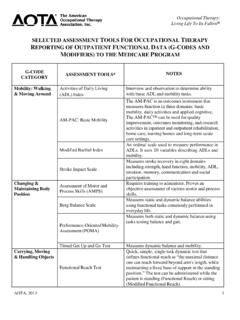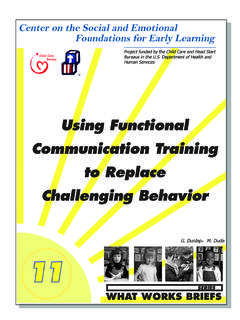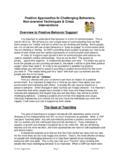Transcription of Picture Exchange Communication System (PECS)
1 Picture Exchange Communication System National Professional Development Center on ASD 2016 1 For more information visit: of the EBP Brief 8. Sam, A., & AFIRM Team. (2015). Picture Exchange Communication System . Chapel Hill, NC: National Professional Development Center on Autism Spectrum Disorder, FPG Child Development Center, University of North Carolina. Retrieved from Communication - System This overview brief will support your use of the evidence-based practice: Picture Exchange Communication System . Picture Exchange Communication System (PECS)---EBP Brief Packet--- Picture Exchange Communication System (PECS)1 of 29 Picture Exchange Communication System National Professional Development Center on ASD 2016 2 Picture Exchange Communication System (PECS) What is Picture Exchange Communication System ?
2 Similar to sign language and Picture boards, PECS is an augmentative and alternative Communication (AAC) AAC systems are used to help individuals who do not have typical verbal skills to communicate with others. PECS is a behavior based intervention that teaches the learner to use visual-graphic symbols to communicate with , 5 Learners with ASD are taught to give a Picture or graphic symbol of a desired item to a communicative partner in Exchange for the actual item through a six phase process. Each phase of PECS instruction builds upon the previous phase. Evidence-base Based upon the recent review, Picture Exchange Communication System meets the evidence-based practice criteria set by NPDC with 4 single case design studies and 2 group design studies. The practice has been effective for preschoolers (3-5 years) to middle school learners (12-14 years) with ASD.
3 Evidence-based practices (EBP) and studies included in the 2014 EBP report detailed how Picture Exchange Communication System can be used effectively to address: social, Communication , and joint attention outcomes. How is PECS Being Used? All team members can use the PECS procedures. However, it is recommended that those interested receive professional training. This module is not intended to take the place of training and resources on PECS provided by Pyramid Educational Consultants, Inc. (the developers and marketers of the PECS System ). Please visit the website: for information on resources and training. The information presented in this module should be implemented under the supervision of a trained professional. For more information visit: 2 of 29 Picture Exchange Communication System National Professional Development Center on ASD 2016 1 Picture Exchange Communication System (PECS) The National Professional Development Center on ASD has adopted the following criteria to determine if a practice is evidence-based.
4 The EBP Report provides more information about the review process (Wong et al., 2014). Efficacy must be established through high quality, peer-reviewed research in scientific journals using: randomized or quasi-experimental design studies (two high quality experimental or quasi-experimental group design studies), single-subject design studies (three different investigators or research groups must have conducted five high quality single subject design studies), or combination of evidence [one high quality randomized or quasi-experimental group design study and three high quality single subject design studies conducted by at least three different investigators or research groups (across the group and single subject design studies)]. --OVERVIEW-- Picture Exchange Communication System (PECS) is used to teach learners with ASD with limited functional Communication skills to initiate communicative exchanges and interactions within a social context.
5 PECS meets the evidence-based practice criteria with 4 single case design studies and 2 group design studies. The practice has been effective with learners in preschool (3-5 years) to middle school (12-14 years). Studies included in the 2014 EBP report detailed how PECS can be used effectively to address: social, Communication , and joint attention outcomes. In the table below, the outcomes identified by the evidence base are shown by age of participants. Early Intervention (0-2) Preschool (3-5) Elementary (6-11) Middle (12-14) High (15-22) No studies Social Social No studies Communication Communication Communication Joint Attention ---Evidence-base for Picture Exchange Communication System --- 3 of 29 Picture Exchange Communication System National Professional Development Center on ASD 2016 2 Early intervention (0-2 Years) No studies Preschool (3-5 years) *Carr, D.
6 , & Felce, J. (2007). The effects of PECS teaching to Phase III on the communicative interactions between children with autism and their teachers. Journal of Autism and Developmental Disorders, 37(4), 724-737. doi: Dogoe, M. S., Banda, D. R., & Lock, R. H. (2010). Acquisition and generalization of the Picture Exchange Communication System behaviors across settings, persons, and stimulus classes with three students with autism. Education and Training in Autism and Development Disabilities, 45(2), 216-229. Jurgens, A., Anderson, A., & Moore, D. W. (2009). The effect of teaching PECS to a child with autism on verbal behaviour, play, and social functioning. Behaviour Change, 26(1), 66. doi: Elementary (6-11 years) *Ali, E., MacFarland, S. Z., & Umbreit, J. (2011). Effectiveness of combining tangible symbols with the Picture Exchange Communication System to teach requesting skills to children with multiple disabilities including visual impairment.
7 Education and Training in Autism and Developmental Disabilities, 46(3), 425. Angermeier, K., Schlosser, R. W., Luiselli, J. K., Harrington, C., & Carter, B. (2008). Effects of iconicity on requesting with the Picture Exchange Communication System in children with autism spectrum disorder. Research in Autism Spectrum Disorders, 2(3), 430-446. doi: *Carr, D., & Felce, J. (2007). The effects of PECS teaching to Phase III on the communicative interactions between children with autism and their teachers. Journal of Autism and Developmental Disorders, 37(4), 724-737. doi: Howlin, P., Gordon, R. K., Pasco, G., Wade, A., & Charman, T. (2007). The effectiveness of Picture Exchange Communication System (PECS) training for teachers of children with autism: a pragmatic, group randomised controlled trial.
8 Journal of Child Psychology and Psychiatry, 48(5), 473-481. doi: Middle (12-14 years) *Ali, E., MacFarland, S. Z., & Umbreit, J. (2011). Effectiveness of combining tangible symbols with the Picture Exchange Communication System to teach requesting skills to children with multiple disabilities including visual impairment. Education and Training in Autism and Developmental Disabilities, 46(3), 425. High (15-22 years) No studies * Research which included participants in multiple age ranges. Picture Exchange Communication System (PECS) 4 of 29 Picture Exchange Communication System National Professional Development Center on ASD 2016 1 This practice guide outlines how to plan for, use, and monitor the Picture Exchange Communication System practice.
9 Keep in mind that PECS teacher the learner to use visual-graphic symbols to communicate with others. BEFORE YOU Each of the following points is important to address so that you can be sure the selected EBP is likely to address the learning needs of your student. Have you found out more information about..? Identified the Collected baseline data through direct Established a goal or outcome that clearly states when the behavior will occur, what the target skill is, and how the team will know when the skill is If the answer to any of these is no, review the process of how to select an EBP. For more information visit: Picture Exchange Communication System (PECS) ---Step-by-Step Guide--- 5 of 29 Picture Exchange Communication System National Professional Development Center on ASD 2016 2 Now you are ready to Step 1: PECS Planning The planning step how to conduct a reinforcer sampling and prepare materials for PECS.
10 Receive PECS training from a certified PECS Training This module is not intended to take the place of training provided by Pyramid Educational Consultants, Inc. For information on training and resources provided, visit the Pyramid Educational Consultants, Inc. website at Establish performance criteria for program goals A minimum of two adults are needed to implement PECS. One adult is identified as the helper and the other adult as the communicative partner . Conduct a reinforcer sampling Reinforcers are needed for using PECS. A reinforcer sampling can be used to identify reinforcers for individual learner. The PECS Reinforcer Sampling found in the Resource section will help you identify potential reinforcers to use with the learner. Conduct assessments Determine the learner s current Communication skills.



















